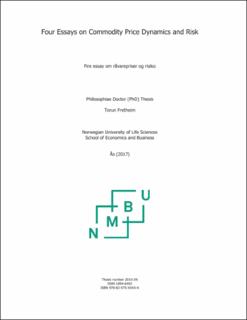| dc.description.abstract | This thesis consists of four empirical studies of commodity markets, with emphasis on agricultural commodities and energy. Employing a variety of time series techniques, I analyze market behavior, price dynamics and risk.
The first essay deals with long-run development, interrelationships and possible structural breaks in the production and pricing of the three major grains, i.e. corn, wheat and soybeans. This is an explorative study, where we look at grain prices and production in a historical (long-term) perspective. Focusing on major political and other events, I analyze long-run price equilibrium, and short-term adjustments of deviations from this equilibrium 1961-2016. My main conclusion is that grain markets generally adjusts smoothly and continuously. This implies that producers and consumers adjust to dramatic events quickly and effectively, perhaps reducing the need for seemingly required regulations imposed by politicians. The first essay also acts as an introduction to the subsequent essays that take a much more short-term perspective oncommodity markets, and the fundamental factors influencing commodity markets.
The second essay is a contribution to the debate on whether speculation is destabilizing commodity markets. Many have argued that commodity prices have been disconnected from their fundamental values. Instead, it is claimed, prices are driven by psychological factors and financial sentiments with similar impacts across commodities that are only remotely (physically) connected. Adopting a framework known from event studies I examine whether oil price shocks, defined as a large price change from one day to the next, are immediately (or rapidly) transmitted to the grain markets. I argue that studying co-movement in the very short term is a way of solving the predicament of disentangling speculative and fundamental influences on commodity prices. My findings do not support the notion of herd behavior and excess co-movement between energy and grain pricess.
My third essay examines hedging behavior in the oil market, and try to answer whether those who are classified as hedgers in the weekly Commitments of Trader reports (published by the U.S. Commodities Futures Trading Commission) are pure hedgers or whether they also take positions based on price expectations. Employing a State Space representation, I find that hedgers in the market for crude oil vary their positions substantially from month to month,
seemingly inconsistent with a risk minimizing hedging strategy. This suggests that there may be a speculative component to hedgers’ trading decisions. My analysis of the relation between oil price variability and hedging commitments suggests that short hedgers focus on truncating their tails to avoid very costly outcomes, rather than pure variance reduction. This is consistent with the theory of selective hedging presented Stulz (1996). I find no significant relation between short hedging commitments and the OVX. Long hedging commitments on the other hand, is negatively related to expected price risk, as measured by the OVX. This is a puzzling phenomenon, as one would expect long hedgers to hedge more in an (perceived) increasingly risky market. The observed relationship might be due to long hedgers reducing the speculative component of their futures portfolio faced with turbulent market conditions.
My analysis supports the findings from Cheng and Xiong (2014)’s study on hedging in agricultural futures, namely that hedgers engage in significantly non-output related trading. However, although I find that hedgers in the oil market trade substantially more than what seems consistent with traditional risk minimizing, I do not agree with the main conclusion in Cheng and Xiong (2014). Since hedgers are typically speculating in the physical market (by adjusting production or leaving their positions exposed to price risk), considering regulations or policy measures geared towards this group appears redundant.
The forth essay is co-authored with Dr. Glenn Kristiansen, and analyses commodity market variability using an Extreme Value Theory (EVT) approach. We add to the literature on food price volatility by analyzing the tail segment of futures price return distributions 1995-2013. Finding no indication of systematically increasing tail risk in agricultural commodity markets, with a possible exception for grains, we conclude that there no general systematic change in the extreme risk associated with commodity investments. Our analysis further support the traditional view that agricultural price volatility is mainly driven by shocks to supply and demand, like adverse weather or dramatic political events. This is an important finding, because volatility driven by fundamentals cannot be tamed by regulation. To the contrary, one needs to look for good ways to manage this risk. | en_US |

